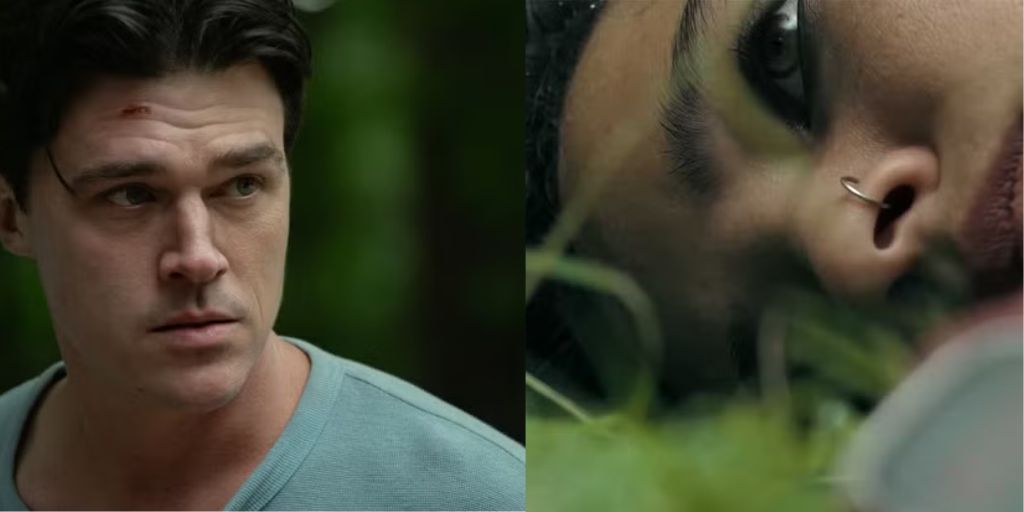Netflix’s Don’t Move offers a tense story of survival and fear set against the backdrop of grief. Directed by Brian Netto and Adam Schindler, this film centers on the struggle of its lead character, Iris, played by Kelsey Asbille, as she faces unimaginable terror.
The plot unfolds with suspense, bringing tension to viewers, but the film ultimately lacks the staying power of memorable horror stories.
Despite its compelling setup, Don’t Move leaves some viewers unsatisfied, reflecting both strengths and missed opportunities within its storytelling.
In Don’t Move, Kelsey Asbille’s Iris, a grieving woman, decides to go on a hike into a remote wilderness.
This area holds painful memories for her because it is the place where her young son passed away. She feels the heavy burden of her grief and begins her journey as a way to come to terms with her loss.
Just as she reaches a moment of deep sorrow, a stranger named Richard appears, offering her company and comfort. Richard seems charming and kind, but soon, his intentions take a dark turn. He quickly reveals his cruel side by taking control of Iris’s situation with frightening efficiency.
Suddenly, the support Iris thought she’d found turns into a dangerous trap as Richard tases her and binds her, leaving her helpless.
When Iris regains consciousness, she realizes she’s been trapped in the back of Richard’s car. The horror intensifies as Richard reveals that he’s injected her with a drug that will leave her fully paralyzed within 20 minutes.
In the face of this terrible fate, Iris is forced to fight for her survival with every ounce of strength she has left, even as her body starts to fail her.
What follows is a harrowing struggle as Iris tries to outwit Richard and escape his grip before the drug completely disables her.
Kelsey Asbille brings depth to Iris’s character through her emotional and physical performance. She effectively conveys Iris’s sadness and deep-rooted fear from the beginning, showing the character’s vulnerability as she mourns her son’s loss.

As the drug begins to take hold, Asbille portrays Iris’s frustration and determination with subtle expressions and trembling movements, creating a sense of claustrophobia and tension for viewers.
Her helplessness and limited physical movements build a nerve-wracking atmosphere, making the audience feel her fear as she fights against her own body.
Finn Wittrock, known for his role in American Horror Story, portrays the character Richard with disturbing intensity.
Wittrock skillfully shows the character’s chilling personality, switching between moments of fake kindness and sudden bursts of violent rage. As a master manipulator, Richard seems to know exactly how to control and terrify Iris, amplifying the tension.
Wittrock’s performance brings out the character’s twisted need for control, making Richard’s sadistic motives evident.
At one point, Richard even senses that Iris has been struggling with her will to live, and rather than simply ending her life, he aims to deepen her despair and take away any remaining sense of power she has.
Despite the strong performances by Asbille and Wittrock, both characters lack depth. The film gives little insight into their backgrounds or motivations, which can make it difficult for viewers to form a strong emotional connection with them.
Some of the dialogue feels awkward, especially during Iris and Richard’s initial interaction. This lack of realism in their exchanges can detract from the film’s impact, as it may remind viewers that these characters are fictional rather than real people in a dangerous situation.
Additionally, a late twist about Richard’s identity, while meant to add intrigue, comes across as predictable, offering little to change our understanding of his character.
The film’s cast is small, with a limited number of supporting characters. Despite this, Daniel Francis and Moray Treadwell offer noteworthy performances that add some variety to the story. Treadwell, who plays Bill, a man who briefly crosses paths with Iris, brings unexpected depth to his role.
When Bill finds Iris in a vulnerable state, his reaction adds a surprising emotional layer to the film. Some viewers might even find Bill to be the most intriguing character, given the limited development of the main leads.
One of Don’t Move’s biggest strengths is the way it builds tension. As Iris races against time to avoid total paralysis while Richard hunts her, viewers are kept on edge, feeling the urgency of her situation.
The suspense remains strong throughout most of the movie, and the looming threat creates a sense of anxiety that lingers, capturing the audience’s attention.
Yet, while the film does manage to sustain this tense atmosphere, it does not fully satisfy fans of traditional horror, as it lacks the depth and intensity found in the genre’s most iconic works.
The film’s soundtrack enhances the sense of fear but also has some jarring moments. Haunting string music plays in the background, adding to the dark mood and helping to build suspense.
However, during the film’s climax, the music suddenly shifts to a different style, using either synthesizers or brass instruments that feel out of place.
This shift in sound may leave viewers distracted during a key emotional moment, which reduces the intended impact.
Although some viewers may find these musical choices unsettling in a good way, others might see them as unintentionally comedic, detracting from the horror experience.

Don’t Move includes scenes with some intense and violent moments that add to the horror, yet the film doesn’t rely heavily on gore to create fear. The story itself and the suspenseful situation carry most of the horror elements.
There are a few scenes where viewers may feel uncomfortable or anxious due to the graphic nature of what’s happening, but these moments are limited.
While these scenes work to some extent, the film completely depends more on its basic concept of terror rather than shocking visuals.
As the film unfolds, certain details raise questions that may break the immersion for some viewers. For instance, given the strength of the paralytic drug, one might wonder why Iris does not lose the ability to breathe as the drug’s effects increase.
Other small inconsistencies, such as her makeup remaining intact despite her physical struggles and near-drowning experiences, can distract the audience from the story.
While these details do not ruin the film, they create a sense of inconsistency that could affect how some viewers perceive the complete experience.
Netflix’s Don’t Move stands out among other thrillers because of its original concept and the way it combines elements of suspense and grief.
The film attempts to find how the deep sorrow from losing a loved one can affect a person’s sense of control and strength, creating a metaphor for the paralyzing effects of grief.
Yet, while it tries to address this emotional theme, the movie falls short of becoming a standout thriller. For those looking for a truly terrifying experience, the slow pace and limited action might feel unsatisfying, making Don’t Move more of a suspense drama than a full-fledged horror.
The film’s unique premise gives it some staying power among Netflix’s many thriller releases, offering an interesting angle on survival and despair.
However, the story’s lack of strong character development and its occasional missteps prevent it from reaching the level of intense horror that some viewers may expect.
In the end, Don’t Move is a film that builds up plenty of tension but ultimately leaves viewers with mixed feelings.
While it captures the desperation and isolation of a woman struggling against a terrifying threat, the film doesn’t quite live up to its potential as a haunting or memorable horror experience.
As Don’t Move reaches its ending, viewers may find themselves reflecting on the themes of control, fear, and grief that permeate the film.
The movie deals with not only the physical battle between Iris and her captor, Richard, but also the emotional struggle within Iris herself.
Grief, in this story, isn’t just a feeling but a force that challenges Iris’s ability to fight for her life. Her journey through both grief and terror highlights how loss can leave someone vulnerable yet desperate to reclaim their strength.
This emotional layer adds complexity to an otherwise straightforward thriller, hinting at the psychological turmoil that trauma and despair can impose on someone’s will to survive.
One of the most interesting aspects of Don’t Move is its attempt to convey the paralyzing nature of grief through a literal paralysis.
Iris’s physical immobility due to Richard’s drug injection reflects how grief can leave a person feeling helpless and unable to move forward.
This dual layer of vulnerability – both physical and emotional – makes Iris a compelling character, especially as she fights back despite feeling lost and weak.
Her journey emphasizes that survival is not just a physical act but also a mental one, where even the smallest act of resistance can become a step toward reclaiming one’s life.

This aspect of the film attempts to provide a deeper narrative, suggesting that strength can emerge from even the darkest places. However, while these themes bring depth, the film’s execution sometimes detracts from its message.
Despite Asbille’s effective portrayal of Iris’s internal and external struggles, the limited character development leaves many aspects of her story unexploited.
The lack of backstory for Iris and Richard restricts viewers from fully engaging with their motivations and past experiences.
Without a clear understanding of who Iris was before her son’s death or what drives Richard’s sadistic behavior, both characters remain somewhat flat.
As a result, the film’s coverage of grief feels underdeveloped, leaving audiences with unanswered questions about Iris’s transformation and Richard’s intentions.
The tension throughout the movie is well-maintained, but Don’t Move could have benefited from additional plot twists or character revelations to break its predictability.
The suspense in Iris’s struggle to escape is engaging, but the lack of narrative complexity makes the film feel more like a surface-level thriller than a nuanced horror story.
Don’t Move maintains suspense but doesn’t fully capitalize on its unique premise, missing opportunities to go deeper into the psychological horror that might arise from Iris’s trauma and fear.
While the film keeps viewers on edge, it falls short of fully finding the emotional and mental turmoil that accompanies Iris’s fight for survival.
For fans of straightforward survival stories, Don’t Move offers moments of suspense, with themes of grief and desperation adding an extra layer of tension.
However, for horror enthusiasts expecting a pulse-pounding, complex story with meaningful character growth, the film may feel like it’s lacking substance.
By balancing its suspenseful atmosphere with moments that reflect on grief and helplessness, Don’t Move stands as an earnest, if imperfect, attempt to blend horror with psychological insight.
Its approach to survival and loss gives viewers something to ponder, but its shortcomings in character depth and unpredictability mean it may not leave a lasting impact in horror cinema.
Don’t Move resonates as a reminder that survival is as much about mental resilience as it is about physical endurance.
Iris’s battle is a testament to human strength in the face of despair, and though the film doesn’t reach horror classics, it offers an experience worth watching for fans of psychological thrillers.
Don’t Move underscores how physical limitations can amplify psychological challenges, especially in life-threatening situations. Iris’s journey emphasizes that even when one feels immobilized by grief or fear, resilience can emerge from unexpected places.
As her character grapples with the effects of paralysis and her terrifying captor, she finds ways to assert her will to survive.
This element of her story offers a subtle, yet powerful, message about the strength individuals can find within themselves, even when they believe they’ve reached their breaking point.
Moreover, Don’t Move raises subtle questions about human connections and isolation in times of grief. By choosing to isolate herself in the wilderness to mourn, Iris inadvertently places herself in a vulnerable situation.
Her interactions with Richard serve as a reminder of how loneliness can sometimes lead to harmful encounters, emphasizing the importance of support systems in times of loss.
While this theme isn’t deeply dealt, it adds another dimension to the story, reminding viewers of the value of connection.




